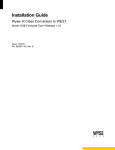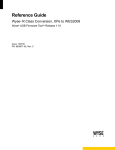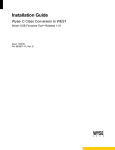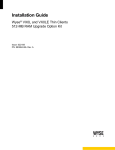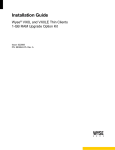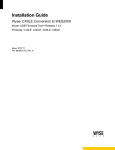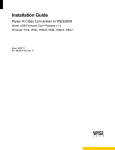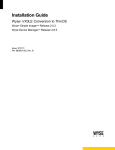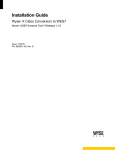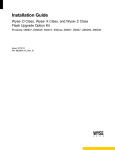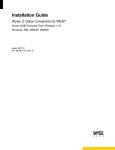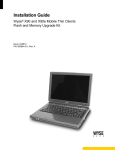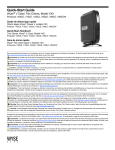Download Dell Wyse VLE class WES2009 2GF/1GR hardware/software
Transcript
Installation Guide Wyse VX0LE Conversion to WES2009 ® Wyse® USB Firmware ToolTM Release 1.13 Products: V10LE, V30LE, V50LE, V90LE Issue: 060811 PN: 883887-26L Rev. A Copyright Notices © 2011, Wyse Technology Inc. All rights reserved. This manual and the software and firmware described in it are copyrighted. You may not reproduce, transmit, transcribe, store in a retrieval system, or translate into any language or computer language, in any form or by any means, electronic, mechanical, magnetic, optical, chemical, manual or otherwise, any part of this publication without express written permission. End User License Agreement (“License”) A copy of the Wyse Technology End User License Agreement is included in the software and provided for your reference only. The License at http://www.wyse.com/license as of the purchase date is the controlling licensing agreement. By copying, using, or installing the software or the product, you agree to be bound by those terms. Trademarks The Wyse logo and Wyse are trademarks of Wyse Technology Inc. Other product names mentioned herein are for identification purposes only and may be trademarks and/or registered trademarks of their respective companies. Specifications subject to change without notice. Restricted Rights Legend You acknowledge that the Software is of U.S. origin. You agree to comply with all applicable international and national laws that apply to the Software, including the U.S. Export Administration Regulations, as well as end-user, end-use and country destination restrictions issued by U.S. and other governments. For additional information on exporting the Software, see http://www.microsoft.com/exporting. Ordering Information For availability, pricing, and ordering information in the United States and Canada, call 1-800-GET-WYSE (1-800-438-9973) or visit us at http://www.wyse.com. In all other countries, contact your sales representative. Contents 1 Introduction 1 Kit Contents 1 Overview 2 Wyse Technical Support 2 Related Documentation and Services Wyse Online Community 2 2 2 Installing Flash and RAM 3 Requirements 3 Procedures 4 What’s Next 6 3 Installing WES2009 Firmware 7 Requirements 7 Procedures 8 Troubleshooting 13 USB Keys - Troubleshooting Boot Issues 13 SanDisk Cruiser Flash Drives - Troubleshooting Partition Issues 13 iv Contents This page intentionally blank. 1 Introduction This guide provides the instructions you need to use Wyse® USB Firmware Tool to convert the following Wyse VX0LE cloud clients to WES2009: • V10LE • V30LE • V50LE • V90LE Caution WES2009 firmware requires VX0LE cloud clients to have a minimum of 2 GB flash and 1 GB RAM. Note After converting your cloud clients, obtain any available firmware update at http://www.wyse.com/serviceandsupport/support/downloads.asp. Kit Contents The conversion kit includes: • Conversion Software Assembly DVD-ROM • Flash module • RAM module • Thermal pad • Wyse Conversion Labels (you must attach a Wyse label to each converted cloud client) • Microsoft License Labels (you must attach a COA label to each converted cloud client) Figure 1 Kit contents (items may look different or not be included in your kit) 2 Chapter 1 The Conversion Software Assembly DVD-ROM contains: • A PDF of this Reference Guide • Wyse USB Firmware Tool v1.13 • VX0LE 2GB WES Conversion Image folder containing the following files: · bios.img · cmos.img · commandsXml.xml · BA.img · initrd.pxe · mbr.img · par1.img · vmlinuz Overview To convert your cloud clients to WES2009: 1. (Optional) If you need to perform a hardware installation (install new flash or RAM), complete "Installing Flash and RAM." 2. (Required) Complete "Installing WES2009 Firmware." Wyse Technical Support To access Wyse technical resources, visit http://www.wyse.com/support. If you still have questions, you can submit your questions using the Wyse Self-Service Center at http://support.wyse.com/selfservice.html or call Customer Support at 1-800-800-WYSE (toll free in U.S. and Canada). Hours of operation are from 6:00 A.M. to 5:00 P.M. Pacific Time, Monday through Friday. To access international support, visit http://www.wyse.com/global. Related Documentation and Services Fact Sheets containing the features of hardware products are available on the Wyse Web site. Go to http://www.wyse.com/products/hardware, click the link for your hardware product, and then click the link for the Fact Sheet. Administrator and other documentation for your cloud client model are available at: http://www.wyse.com/manuals. Wyse Online Community Wyse maintains an online community where users of our products can seek and exchange information on user forums. Visit the Wyse Online Community forums at: http://community.wyse.com/forum. 2 Installing Flash and RAM This chapter contains information for Wyse V10LE, V30LE, V50LE and V90LE cloud client users who must install new flash and RAM. If you are installing firmware only, you can skip this chapter and proceed to "Installing WES2009 Firmware." Caution (V90LE Only) For V90LE users who do not have a minimum of 2 GB flash, you must install new flash (all V90LE users have 1 GB RAM and can skip "Step 3: Install the RAM Module"). For V90LE users who have a minimum of 2 GB flash and 1 GB RAM, skip this chapter and continue with "Installing WES2009 Firmware." Requirements • Small Phillips screwdriver • Small Flat-Edge screwdriver Warning Flash and RAM modules may be susceptible to damage by Electro-Static Discharge (ESD). All industry-standard cautions should be followed to avoid ESD. Before you remove or install a module, touch any metal part of the chassis and keep that contact with the chassis during the installation process. 4 Chapter 2 Procedures Step 1: Remove the Top Cover Caution Follow all precautions listed in the Quick-Start Guide that came with your cloud client for disconnecting and reconnecting the cloud client. 1. Perform a proper shutdown of the cloud client by closing all files and ending your session, and then press the power button to turn off the cloud client. 2. Unplug the power cord and power adapter, remove all of the cables from the rear of the cloud client, and then detach any vertical foot. 3. Position the cloud client horizontally, remove the two screws from the rear of the cloud client using a small Phillips screwdriver. Figure 2 Removing the rear screws 4. Remove the top cover from the cloud client by inserting the tip of a small Flat-Edge Screwdriver just inside the edge of the lock receptacle to make contact with the metal liner that lines the opening. Apply pressure inward and downward on the metal liner while pulling up on the plastic housing until it releases as shown in Figure 3. Figure 3 Removing the top cover 5. Lift the top cover to remove it and expose the main board as shown in Figure 4. Notice that the rear of the cloud client is positioned at the bottom of the photo. Installing Flash and RAM 5 Step 2: Install the Flash Module Warning Flash modules may be susceptible to damage by Electro-Static Discharge (ESD). All industry-standard cautions should be followed to avoid ESD. Before you remove or install a module, touch any metal part of the chassis and keep that contact with the chassis during the installation process. 1. Note where the connector of the flash module is located in Figure 4. Remove the existing flash module from the socket. Figure 4 Removing the existing flash module 2. Install the new flash module in the reverse order of removing the original flash module making sure to align the plastic tab of the module’s connector with the notch in the connector on the board. Step 3: Install the RAM Module Warning RAM modules may be susceptible to damage by Electro-Static Discharge (ESD). All industry-standard cautions should be followed to avoid ESD. Before you remove or install a module, touch any metal part of the chassis and keep that contact with the chassis during the installation process. 1. Note where the connector of the RAM module is located in Figure 5. Remove the existing RAM module. Use your fingers to unlock the two retaining clips at either side of the RAM module by pushing in the direction of the arrows shown in Figure 5. The module should pop up from its socket. Lift out the RAM module. Figure 5 Removing the existing RAM module 6 Chapter 2 2. Install the thermal pad by peeling off the clear strip and placing it (with textured strip facing up as shown in Figure 6) where the module was located. Make sure that the pad does not interfere with the connector pins or module locking clamps, and then lightly press to secure. Figure 6 Installing thermal pad 3. Peel off the colored textured strip from the thermal pad as shown in Figure 7, and then with its label facing down, install the new RAM module in the reverse order of removing the original RAM module. Carefully press down on the RAM module until its retaining clips lock it into place. Figure 7 Installing new RAM module Step 4: Reassemble the Cloud Client 1. Replace the top cover in the reverse order as described in "Step 1: Remove the Top Cover." 2. Attach any vertical foot. 3. Reconnect the video display, keyboard, mouse, network cable, and power adapter to the cloud client before connecting to an electrical outlet. Caution Do not turn on the cloud client. The cloud client is ready to re-image, however the flash module does not contain an operating system. Turning on power to your cloud client without firmware will display the error message “NO OPERATING SYSTEM FOUND.” What’s Next Continue with "Installing WES2009 Firmware." 3 Installing WES2009 Firmware This chapter includes the requirements and procedures you need to install and use Wyse® USB Firmware Tool to update your cloud client to WES2009 firmware. Tip The purpose of the Wyse USB Firmware Tool is to configure a bootable USB key for device firmware. In the following procedures, you will create a configured USB key containing the firmware contents that you need, and then boot from this configured USB key on appropriate product and flash size devices to push the contents of the USB key onto these target devices. Requirements • • Machine with a minimum of 4 GB of free space running either of the following: · Windows XP Professional SP3 · Windows 2003 Server · Windows Server 2008 R2 · Windows 7 Enterprise (32-bit and 64-bit) · Windows 7 Ultimate (32-bit and 64-bit) USB key size should be 4 GB or larger (up to 16 GB tested—see "USB Keys Troubleshooting Boot Issues") Caution During the USB key configuration process the USB key will be reformatted. 8 Chapter 3 Procedures Complete the following procedures as an administrator (administrator privileges are required). Step 1: Copy the VX0LE 2GB WES Conversion Image Folder to Your Local Hard Drive Navigate to the VX0LE 2GB WES Conversion Image folder (contained on the Conversion Software Assembly DVD-ROM) and copy it to your local hard drive. Step 2: Install Wyse USB Firmware Tool 1.13 1. Navigate to the Wyse USB Firmware Tool v1.13_GA.exe (contained on the Conversion Software Assembly DVD-ROM) and double-click it to execute the file and open the WinZip Self-Extractor dialog box. Figure 8 Extract files to your hard drive (C:\USBFT113) 2. Enter C:\USBFT113 in the Unzip to folder box, and then click Unzip to extract all files from the Wyse USB Firmware Tool v1.13_GA.exe file into the C:\USBFT113 directory. The default directory for the extracted files is Wyse USB Firmware Tool. Caution It is not recommended to use your desktop for the destination directory as there are several files that will be extracted from the .exe file. 3. Create a shortcut on the desktop for the Wyse USB Firmware Tool.exe file. Step 3: Use Wyse USB Firmware Tool to Configure a Single USB Key to Install Firmware 1. Double-click the shortcut on the desktop for the Wyse USB Firmware Tool.exe file to run the tool and open the Wyse USB Firmware Tool wizard (the welcome page provides the product version and description, and a link to view the Wyse end user license agreement). Caution For Windows 7 Enterprise and Windows 7 Ultimate operating systems, be sure to right-click on Wyse USB Firmware Tool.exe and select the Run as administrator option). Installing WES2009 Firmware Figure 9 9 Wyse USB Firmware Tool wizard 2. Click Next to open the Select an Option dialog box. Figure 10 Configuration options 3. Select the Configure a single USB key to Copy or Update firmware option, and then click Next to open the Select the Configuration dialog box. Figure 11 Update firmware options 4. Select the Windows Embedded Standard operating system (OS) type option. 5. Select the Update Firmware operation to perform option. 6. (Optional) Leave the default-selected Preserve data partition check box (recommended in most cases) unless you do not want to preserve any existing custom 10 Chapter 3 data partition you have on the cloud client (outside of the partition used by the firmware). Tip This option is only available for use with cloud clients using multiple data partitions totalling 4 GB or larger, allowing you to remove the partition used for custom data that is not write filter protected (this is the custom data partition outside of the partition used for write filter protected firmware). 7. Select all three contents options (OS Image, BIOS, and CMOS). 8. Click Next to open the browse dialog box. Figure 12 Browse for image file 9. Click Browse. Figure 13 Browse to select commandsXml.xml 10.Navigate to the VX0LE 2GB WES Conversion Image folder on your hard drive (this is the location you selected in "Step 1: Copy the VX0LE 2GB WES Conversion Image Folder to Your Local Hard Drive"), click on the commandsXml.xml file to select it (you may need to select the All Files option from the Files of Type box to display the commandsXml.xml file for selection), and then click Open. Caution Do not use the commandsXml.xml file directly from the Conversion Software Assembly DVD-ROM. 11. In the browse dialog box, click Next to open the Prepare the USB Drive dialog box. Installing WES2009 Firmware Figure 14 11 Prepare USB drive 12.Select the USB key onto which you want the configurations (you can use Refresh as needed to recognize an inserted USB key), and then click Next. The progress bars show the overall (formatting and configuration) progress and task progress. 13.After configuration, click Finish to close the wizard and then remove the configured USB key for use (you will use the configured USB key on your target devices). Tip At this time you can also replicate/duplicate the configured USB key (containing the firmware you want to push) for simultaneous usage on target devices (by users in several locations at the same time). For full Wyse USB Firmware Tool details, see Users Guide: Wyse® USB Firmware Tool 1.13. Step 4: Use the Configured USB Key to Install Firmware on Each Cloud Client In this step, you will boot each cloud client you want to convert from the configured USB key so that the USB key will push the contents from the USB key onto the target device. 1. Be sure the client is shut down and disconnected from any network. 2. Attach the configured USB key to the client. 3. Power on the client and during boot, press and hold the P key. 4. Select the Hard Disk option from the menu. 5. Select the USB-HDD0 drive option from the menu (this option also displays the brand of your configured USB key). 6. Press Enter and follow the process prompts. When booting a target device from the configured USB key (containing the contents to be pushed to a target device), you will be prompted to continue with the push process (to continue, type y and press Enter). Once the push process is complete, you must reboot (press Enter and remove the USB key). Caution DO NOT interrupt the installation/conversion process. All process requirements are done automatically. Some screens may display for several seconds during the process. You can safely ignore any error message after reboot. After any error message, your target device will automatically reboot. 7. After a target device completes the installation/conversion process and displays the WES2009 desktop, continue with "Step 5: Verifying Cloud Client Operation." 12 Chapter 3 Step 5: Verifying Cloud Client Operation After the cloud client displays the WES2009 desktop, you can verify the Version and that your general client information is correct. 1. On the General tab of the Client Information window (Start > All Programs > Client Information), verify the following: • Version is 8.01 (Build 0688.2048) for the 2-GB flash configuration. • Windows WES Version is 5.01 Service Pack 3. 2. Click OK to close the Client Information window. The cloud client is ready for operation and setup by an administrator. NOTE: Depending on your network setup, the cloud client may automatically reboot once the device is initially connected to the network. Tip For security, automatic logon to a User desktop is enabled on the cloud client by default (and is a member of the User group; not a member of the Administrator group). To log on as a different user or an administrator: Use the Log off button (Start > Log off) to log off the current desktop while holding down the SHIFT key until the Log On window displays. Log on as follows (passwords are case sensitive): Administrators - default Username is administrator and default Password is Wyse#123. Users - default Username is user and default Password is Wyse#123. Administrator and other documentation for your cloud client are available at: http://www.wyse.com/manuals. Step 6: Attach a Wyse Conversion Label and Microsoft License Label on Each Converted Cloud Client The conversion kit is supplied with Wyse Conversion Labels and Microsoft License Labels that must be attached to each cloud client. Be sure you have purchased the amount of labels you need. Caution Failure to install the labels may cause delays in service and support. The serial number must be given to a Customer Support Technician to validate entitlement to support and service from Wyse. Failure to do so will result in the original operating system being loaded on the device and is in breach of your license agreement. Step 7: Obtain a Firmware Update After converting your cloud clients, obtain any available firmware update at http://www.wyse.com/serviceandsupport/support/downloads.asp. Caution Be sure to select the V90LEW option (for example, V90LW/V90LEW) in the Product Downloads Active box, click Search, and use the V90LEW Active Firmware link you need (for example, WES V90LW/V90LEW Image). Warning Use of the Software on more than one device requires that you first purchase from Wyse additional copies of, or licenses to, the Software. Contact your local Wyse distributor or Wyse Inside Sales at 1-800-800-9973 option 1 or 1-408-473-1200 option 1. Installing WES2009 Firmware 13 Troubleshooting This section contains general troubleshooting information. USB Keys - Troubleshooting Boot Issues Due to different manufacturing processes on USB keys (and the variety of them), not all brands have been tested with the Wyse USB Firmware Tool. If you experience problems booting from a configured USB key, it is recommended that you try a different brand of USB key. The following list of USB keys have been successfully tested with the Wyse USB Firmware Tool: • Kingston Data Traveler 4 GB • Kingston Data Traveler 8 GB • SanDisk Cruzer micro 4 GB • SanDisk Cruzer micro 8 GB • SanDisk Cruzer micro 16 GB • Transcendent 4GB SanDisk Cruiser Flash Drives - Troubleshooting Partition Issues Problem: How can I properly use a SanDisk Cruiser flash drive to image supported devices using the Wyse USB Firmware Tool? (KB17735) Solution: SanDisk flash drives come with support for U3 (for details on U3, see http://www.u3.com). When you initially use these drives, you are prompted to select the use for the drive: Apps and Storage or only Storage. If you select the Apps and Storage option, the drive will create two partitions, one of which is identified as a CD and is a read only partition. This partition sometimes prevents the Wyse USB Firmware Tool to properly prepare the USB key for imaging a device. To resolve this problem you can do one of the following: • Go to http://www.sandisk.com, search in the SanDisk Knowledge Base for document 2550, and then follow the instructions in the documentation. • Go to http://www.sandisk.com/DriverDownload/driverList.asp, select USB Flash Drives from the Select Product Type list, click Find Driver, select U3 LaunchPad Remover, click Continue, and then download and use the U3 Launchpad Remover according to the instructions. Installation Guide Wyse® VX0LE Conversion to WES2009 Issue: 060811 Written and published by: Wyse Technology Inc., June 2011 Created using FrameMaker® and Acrobat®


















